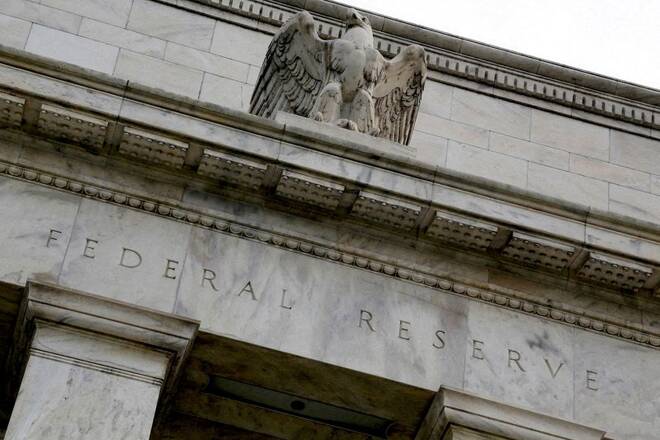Advertisement
Advertisement
Another Fed milestone? Policy peak with negative real rates: McGeever
By:
By Jamie McGeever ORLANDO, Florida (Reuters) - The Federal Reserve could be set to follow its historic interest rate-hiking campaign with another policy milestone - ending a tightening cycle with negative real rates.
By Jamie McGeever
ORLANDO, Florida (Reuters) -The Federal Reserve could be set to follow its historic interest rate-hiking campaign with another policy milestone – ending a tightening cycle with negative real rates.
There are a few variables at play – not least incoming economic and inflation data – but it is not unreasonable to think the Fed’s most aggressive rate-hiking campaign in 40 years could end with the real policy rate still below zero.
This is what interest rate futures markets are currently indicating. If it comes to pass, it will be the first time in at least 50 years that the peak in a Fed tightening cycle will be below the prevailing rate of headline annual inflation.
To be sure, there are several ways of calculating real rates. If the fed funds rate is discounted by core PCE inflation, the real interest rate is currently a positive 0.275%, and rising.
Still, the fed funds rate minus headline annual PCE or CPI inflation are decent, if crude, measures. There is data for each of these metrics going back decades, and headline inflation is what directly affects most people in the country.
Right now, the fed funds target range is 4.75%-5.00%, the mid-point of which is 4.875%, and the last snapshot of annual headline CPI inflation in February was 6%. That gives a real policy rate of -1.125%.
Using annual headline PCE inflation of 5% in February, the real fed funds rate is only -0.125%. Obviously, that is close to turning positive and could easily do so if March PCE inflation falls to any reasonable degree.
Real policy rates were positive for at least two decades up until 2002. Since the Great Financial Crisis, in the era of zero interest rates and quantitative easing, they have been mostly negative.
There has been one notable exception since 2008, however: late 2018-late 2019. The Fed ended its last mini-hiking cycle in December, 2018, just as real rates turned positive.
Approaching the end of a hiking cycle with a negative real fed funds rate – on the face of it, extremely stimulative policy – is a rare place for the Fed to be.
“It’s a weird dynamic – it says a lot about where markets see inflation going. They see it disappearing and disappearing quite quickly. Markets think recession will take care of inflation,” said Callie Cox, U.S. investment analyst at eToro.
Market says fed already done
Cox thinks the bond market may be underestimating how sticky inflation is, and reckons persistently higher inflation is the No. 1 risk investors face right now.
The March CPI report will be released on April 12 and the next PCE inflation data is scheduled for April 28. The Fed’s next policy meeting is May 2-3.
Many policymakers insist rates need to be raised and held above 5%, which would see “the real fed funds rate staying in positive territory for some time,” Cleveland Fed President Loretta Mester said this week.
Financial markets don’t agree. Rates futures pricing suggests the hiking cycle is over, and that the Fed will cut rates by 75-100 basis points by the end of the year.
If history is any guide, nominal rate cuts put downward pressure on real rates. Given where they are right now, it is reasonable to assume they would go deeper into negative territory.
This raises questions about so-called ‘R*’, the unknowable ‘natural’ real rate of interest over the longer term that neither heats up nor cools down the economy.
If the pandemic supply shocks in energy, food, commodities, and microchips represent a structural shift that will keep price pressures elevated, the neutral level of real rates may be higher too.
But if a looming slowdown turns into recession and the aftershocks of the banking crisis slam credit and lending across the economy, inflation could slow sharply. This would push R* lower.
For its part, the Fed sees the real fed funds rate ending this year around +180 bps, based on its median fed funds and PCE inflation projections of 5.1% and 3.3%, respectively.
Bank of America rates strategists think this is far too optimistic, and real policy rates will be much lower. “Longer-dated real yields are a ‘buy’, one of our highest conviction macro trades for 2023,” they wrote in a recent note.
The 10-year real yield – the yield on 10-year inflation-linked Treasury bonds, or TIPS – has plunged more than 150 bps since the banking shock just about a month ago to 1.05%, which is where the 5-year TIPS yield is also hovering.
The 20-year TIPS yield is even lower – just 0.05%.
(The opinions expressed here are those of the author, a columnist for Reuters.)
(By Jamie McGeever; Editing by Andrea Ricci)
About the Author
Reuterscontributor
Reuters, the news and media division of Thomson Reuters, is the world’s largest international multimedia news provider reaching more than one billion people every day. Reuters provides trusted business, financial, national, and international news to professionals via Thomson Reuters desktops, the world's media organizations, and directly to consumers at Reuters.com and via Reuters TV. Learn more about Thomson Reuters products:
Advertisement
